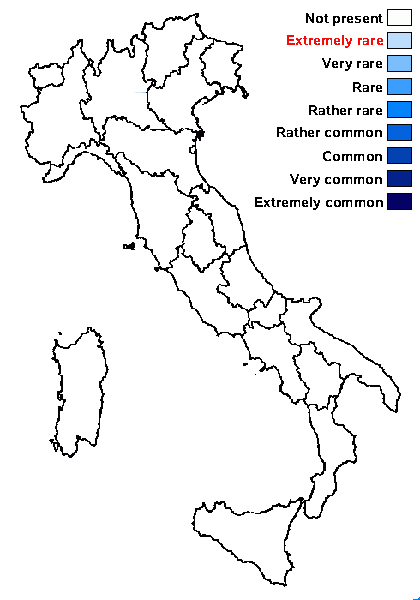Umbilicaria corsicae Frey
Rabenhorst's Kryptogamen-Flora von Deutschland, Österreich und der Schweiz, vol. 9, Abt. 4/1: 320, 1933.
Synonyms: Umbilicaria maculata Krzew., M.P. Martín & M.A. García
Distribution:
Description: Thallus foliose-umbilicate, heteromerous, dorsiventral, monophyllous, up to 3 cm wide, the margins with or without sparse marginal cilia, attached by a central holdfast. Upper surface smooth, dull, grey to grey-brown, white in places where the cortex is thinner (giving a maculate appearance), paler and scabrous to areolate in central parts. Lower surface smooth, dull, pale creamy white, darker towards the margins with pale, simple to dichotomously divided, flattened, rarely cylindrical rhizinomorphs, the area around the umbilicus erhizinate; thalloconidia absent. Medulla white, two-layered, the upper layer loose, with an arachnoid plectenchyma, the lower layer with a compact plectenchyma. Apothecia frequent, sparse, black, sessile, up to 1(-2) mm across, omphalodisc with a large sterile fissure in the centre or with a few sterile fissures, the margins characteristically incised. Epithecium dark brown, up to 20 µm high; hymenium colourless, up to 50 µm high; paraphyses usually simple, up to 2.5 µm thick, the apical cells hardly swollen; hypothecium dark. Asci 8-spored, clavate, thick-walled, with an amyloid apical dome, Umbilicaria-type. Ascospores 1-celled, hyaline, ellipsoid, 10-12 x 5-6 µm. Pycnidia common, more dense in the marginal zone, immersed, with a brown wall and a dark brown ostiole, the conidiophores unbranched, septate. Conidia cylindrical, c. 4 x 0.8 µm. Photobiont chlorococcoid. Spot tests: cortex and meculla K-, C-, KC-, P-, UV-. Chemistry: without lichen substances.Note: a species described from Corsica, and also known from the Pyrenees, the Western Alps (France) and the Tatra Mnts. (Poland), but probably more widespread, having been likely confused with U. cylindrica; it grows on steeply inclined to vertical surfaces of large blocks of siliceous rocks in rather shaded and wind-exposed places. For the synonymisation of the recently-described U. maculata (Krzewicka & al. 2009) see Roux & Coll. (2025). To be looked for in Italy.
Growth form: Foliose, umbilicate
Substrata: rocks
Photobiont: green algae other than Trentepohlia
Reproductive strategy: mainly sexual

Predictive model
Growth form: Foliose, umbilicate
Substrata: rocks
Photobiont: green algae other than Trentepohlia
Reproductive strategy: mainly sexual

Predictive model

